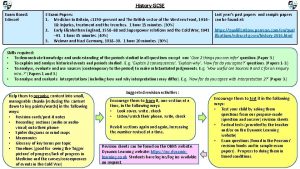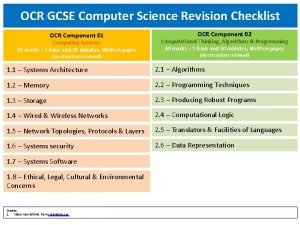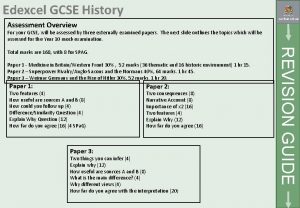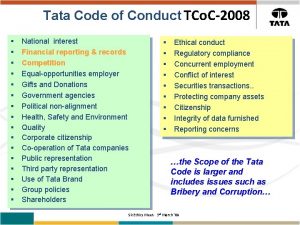Geography GCSE Revision Edexcel Specification A CDunneTYork c2008



























- Slides: 27

Geography GCSE Revision Edexcel Specification A CDunne/TYork (c)2008

Getting Organised! E. G. Mon Tues Wed Thu 16/04 23/04 30/04 07/05 14/05 21/05 CDunne/TYork (c)2008 Fri Sat Sun

CDunne/TYork (c)2008

Economic World PRIMARY ACTIVITY Factors Affecting Farming Social & Economic Factors • Labour • Capital (money • Technology • Markets • Government Economic Activities: 1. Commercial and Subsistence Farming Systems 2. How Farming is Changing Farming as a System Inputs • Sunlight • Rainfall / water supply • Land / soil • Labour (workforce) • Capital (money) • Seeds / fertiliser / pesticides • animals Processes • Cultivation of crops e. g. ploughing, irrigation • Rearing of animals Outputs • Crops • Animal products e. g. milk / meat • Outputs: a) To sell b) Farmer’s own use Feedback Do you know your case studies? Intensive Wet Rice Farming Philippines EU Changes in the UK (CAP) Environmental Factors • Climate • Relief • Soil Types of Agriculture 1. Enterprise: • Arable • Pastoral • Mixed 2. Intensity of Production: • Intensive • Extensive 3. Subsistence/Commercial CAP – Make sure you know what is this and what changes it brought: Diversification Set-aside Quotas CDunne/TYork (c)2008 List examples of other primary activities.

Classification of Farming 1. 2. 3. 1. 2. Specialisation Arable – Pastoral – Mixed – Economic Status: Commercial farming Subsistence farming – Intensity of Land Use: Extensive Intensive CDunne/TYork (c)2008

Types of Farming – Global General Knowledge Type of Farming Example Nomadic Hunting Aborigines, Australia Nomadic herding Maasai in Kenya Shifting cultivation Amerindians in Amazonia Intensive subsistence agriculture Rice farming in the Ganges Delta Plantation agriculture Sugar cane in Brazil Livestock ranching (commercial pastoral) Beef on the Pampas Cereal cultivation Canadian Prairies Mixed farming Netherlands Mediterranean agriculture Southern Italy Irrigation Nile Valley, California Unsuitable Sahara Desert CDunne/TYork (c)2008

Factors Affecting Farming Relief Soils Physical Factors Temperature Rainfall CDunne/TYork (c)2008

Factors Affecting Farming Government aid Fertiliser Marketing Human Factors Competition for land Size of farm Mechanisation CDunne/TYork (c)2008

Common Agricultural Policy 1. 2. 3. Created in 1962 Aims: To protect farmers’ incomes To ensure reasonable and steady prices for consumers To increase production to provide sufficient food supplies CDunne/TYork (c)2008

CAP achieved by … 1. 2. Grants and subsidies – money for farmers who farm in difficult areas Price support – a guaranteed minimum price for agricultural produce (may cause surpluses Very expensive – sustainable? CDunne/TYork (c)2008

Case Study: How is Farming Changing? 1. 2. 3. 4. 5. Home Farm, West Midlands Set aside: EU funded scheme to reduce surpluses Farmers are paid not to grow anything for 5 years (left fallow) Payment = up to £ 300 per year! Diversification to Caravans and B&B Renting land out for Grazing CDunne/TYork (c)2008

Case Study: How is Farming Changing? 1. 2. a) b) Diversification: This is when farmers develop business initiatives other than farming Examples: Barns converted in to holiday cottages, garden centres and farm shops Tea shops CDunne/TYork (c)2008

Case Study: How is Farming Changing? 1. 2. 3. 4. 5. Agribusinesses: Large-scale, highly efficient farms Organised on scientific and business principles Includes a chain of suppliers and retailers Belongs to a group of other farms Able to reduce cost of inputs – economies of scale CDunne/TYork (c)2008

Quick Quiz 1. Make a list of all the factors that affect farming – you mind find it easier to split them into physical and human factors. 2. What are: a) Arable farms b) Pastoral farms c) Mixed farms? 3. Explain what is meant by the following: a) Intensive farms b) Extensive farms c) Subsistence farms d) Commercial farms 4. What does CAP stand for? 5. What is diversification? CDunne/TYork (c)2008

The Economic World – SECONDARY ACTIVITIES What other types of economic activity are there? Economic Activities: 1. The location of manufacturing industries 2. The location of distribution industries Industry as a System Inputs • Raw materials • Land • Labour • Power • Transport • Capital (money) Outputs • Finished product for the consumer or to other industries • Waste products Processes Making the goods • Process • Packaging • Distribution Profit Reinvested Profit or Loss Employment Structure – label and explain. The first ‘chunk’ is primary, the secondary and the last tertiary. Uganda Case Studies: Heavy industry e. g. iron & steel Industry Footloose Industry e. g. Hi-tech industry Distribution Industry e. g. Argos, Stafford Can you interpret a Triangular Graph? UK ©C Dunne 2005 Location of Industry Where? Why? CDunne/TYork (c)2008

Location Factors Large, flat site Market Raw materials What is needed? Labour Energy Transport (links) CDunne/TYork (c)2008

High-Tech Industries Bracknell Computer Development Why have they located here? (Where is it exactly? ) The following may give you a few clues but make sure you have re-read the case study. These may be described as ‘footloose’ because they are not really restricted by the location factors of raw materials e. g. pc factories Tend to opt for locations near major route ways e. g. M 4 / M 11 corridors Also locate near university sites – research facilities Would prefer sites that area aesthetically pleasing for their workers YOU NEED TO KNOW THIS CASE STUDY! CDunne/TYork (c)2008

Formal and Informal sectors What are the differences? What characterises an informal sector job? What is the advantage of a formal sector job? CDunne/TYork (c)2008

Some industries are classed as Heavy Industry e. g. Iron and steel 1. 2. 3. 4. 5. 6. 7. 8. South Wales – e. g. Ebbw Vale, Merthyr Tydfil Natural Advantages: Coalfields Limestone Iron ore Flat site (of Valley) River (Rhonnda) – cooling finished product Local settlements – work force Port (gateway to the British Empire – market) These areas are where industry used to be but then it moved for several reasons. CDunne/TYork (c)2008

How did location factors change? Empire countries gained independence – more competition; market not as strong Coal and iron ore reserves were becoming exhausted (running out!); seams were too thin to mine or inaccessible (making it more expensive to mine) Original valley site not big enough for modern factories Coastal areas were better as they were the areas where relatively cheap imported materials were coming in There were better places in the world to make things that were cheaper – Place like Britain got rid of lots of their industries to countries like Brazil. CDunne/TYork (c)2008

Brazil - Fiat What is a Trans National Company (TNC) Why did Fiat move from Italy to Brazil? Why did Fiat expand in Brazil? CDunne/TYork (c)2008

Bonus Knowledge The Decline of Manufacturing De-industrialisation – the growing importance of tertiary (Service and Tourism) and quaternary (High tech Research and Development e. g. NASA) industries Port Talbot steelworks is the only one remaining in Wales; Llanwern steelworks closed in 2001 (1300 jobs lost) CDunne/TYork (c)2008

The Reason for the Decline 1. 2. 3. Globalisation: many companies compete on a global scale competition is strong constantly looking for cheaper raw materials and/or manufactured goods CDunne/TYork (c)2008

The Consequences Coal mine / steel works close High unemployment People have less money to spend on goods and services Fewer taxes and business rates paid to the council Less investment by council for education, schools and other key services Young people leave school with fewer/poorer qualifications People have more time, less opportunities, less money Petty crime often increases Environmental decline CDunne/TYork (c)2008

Political Responses 1. 2. 3. Development areas – government gives financial assistance (in what forms? ) Encouragement of new industries in the area of decline: Retail parks – using the old steelworks site (a bit like Bluewater – old gravel pit) Tourism – heritage site / museum Manufacturing (hi-tech) – LG now located there (but this brings with it other problems. Can you think of any? ) CDunne/TYork (c)2008

Distribution Industries E. g. Argos Warehouse, Staffordshire Central location Can reach any of their stores by over-night delivery Located on the junction 34/A 51 on the M 6 Lots of space to house the huge warehouse CDunne/TYork (c)2008

Quick Quiz Name the 4 types of industry How does this classification help when talking about the employment structure and development of a country? Briefly define/explain the term system List the important factors when considering the location of industry What is heavy industry? Which case study? Where? Why? What happened? What is a footloose industry? CDunne/TYork (c)2008
 Aqa gcse geography revision checklist
Aqa gcse geography revision checklist Edexcel gcse pe specification
Edexcel gcse pe specification Geography gcse revision notes
Geography gcse revision notes Macbeth extract questions
Macbeth extract questions Edexcel business specification
Edexcel business specification Active and passive vocabulary
Active and passive vocabulary If lclp is negative number, we set the lclp = 0. why?
If lclp is negative number, we set the lclp = 0. why? Upper specification limit and lower specification limit
Upper specification limit and lower specification limit Edexcel art gcse past papers
Edexcel art gcse past papers Pearson edexcel international gcse english anthology
Pearson edexcel international gcse english anthology Edexcel gcse history past papers
Edexcel gcse history past papers Edexcel gcse drama
Edexcel gcse drama Edexcel gcse english literature
Edexcel gcse english literature An inspector calls exam questions edexcel
An inspector calls exam questions edexcel Edexcel gcse pe 9 mark question examples
Edexcel gcse pe 9 mark question examples Edexcel gcse history crime and punishment past papers
Edexcel gcse history crime and punishment past papers Gcse
Gcse Edexcel music gcse
Edexcel music gcse Edexcel gcse music set works
Edexcel gcse music set works Edexcel english literature paper 2 2019
Edexcel english literature paper 2 2019 Edexcel english
Edexcel english English language paper 2 transactional writing
English language paper 2 transactional writing Aqa gcse maths revision checklist
Aqa gcse maths revision checklist Product design gcse revision
Product design gcse revision What is this
What is this Food technology gcse revision
Food technology gcse revision Gcse catering revision
Gcse catering revision History gcse spec
History gcse spec

















































